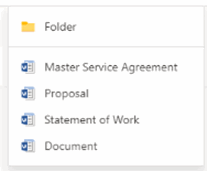Maintaining Control and Findability of Information on Microsoft 365
Over the last few months, organizations have feverishly deployed Microsoft Teams to support virtual meetings and the “new normal” of working from home. With the associated increase in file sharing, collaboration, and storage, it is important to consider information and content management to avoid knowledge loss.
Teams is a significant part of the Microsoft 365 subscription, and currently one of the most attractive. It is defining a new digital workplace by harnessing the capabilities of many other components, such as Skype and Yammer. A multitude of other collaboration tools, including Slack and Jira, integrate with Teams.
Although often overlooked, every Teams implementation is underpinned with a SharePoint site that eases collaboration and content storage through Document Libraries and Lists. The ability to formally define and manage information is inherently available within Teams via SharePoint’s Content Types.

- What are SharePoint Content Types? Content Types define an item’s properties (metadata), policies, and templates; they can be defined in a central hub so they can be used in any Teams or SharePoint site.
- How to enable Content Types? Once created, they can be made available to the Document Libraries used by Teams’ Files tab or with SharePoint Lists.
- What are the benefits? Content Types can significantly improve adoption and end-user satisfaction through better access control, improved search results, and structured management of key files and data. In short, they put structure around what would otherwise be unstructured.
In a scenario where you have similar Teams, such as sites for projects or sales opportunities, it will be well worth the time to define Content Types for the information you would like to see developed and managed consistently, such as contracts, statements of work, and project status reports.
You might even consider automating the Teams or SharePoint site provisioning to include the right set of pre-configured lists and libraries, including Content Types, to really drive best practices throughout your organization. Microsoft 365 supplies a variety of ways to provision new sites while tailoring the results. Using the Power Platform and/or Azure Services—such as Functions—with the SharePoint Framework and Graph API, can promote consistency if done right.
Either way, it is critical to ensure that the best material your organization develops does not stay tucked away in a Teams or SharePoint site. Establishing Information Management practices that are promoted and even formalized in (dare I say the G-word) “governance,” is the first step to ensuring your organization’s critical information and data assets are not forgotten, ignored, and discarded over time in an abandoned SharePoint or Teams site.
Social media cookies must be enabled to allow sharing over social networks.